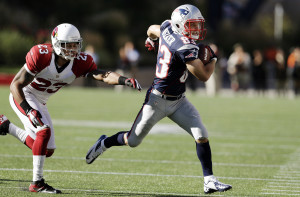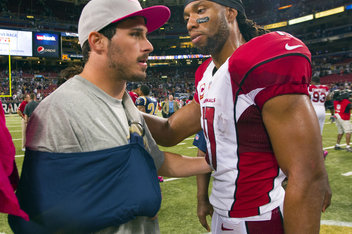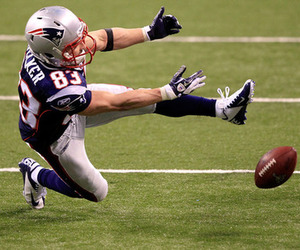by Chase Stuart
on August 1, 2013
If you don’t play fantasy football, you probably have no idea what this title means. Of course, it’s 2013, so if you don’t play fantasy football, you’re now the oddball. “PPR” stands for points per reception. About half of all fantasy leagues do not give any points for receptions, while the other half includes some sort of PPR format. And while the value of every player is dependent on each league’s scoring system, few players see their value fluctuate between scoring systems quite like Wes Welker. Or, at least, that’s how it seems. Is there a way to measure this effect?
First, a review of Welker’s numbers since he joined the Patriots:
Welker doesn’t get many touchdowns, and while he has respectable yardage totals, he is only exceptional when it comes to piling up receptions. Welker has 672 receptions over the last six seasons, easily the most in the NFL (in fact, it’s the most ever over any six-year stretch). Brandon Marshall (592) and Reggie Wayne (578) are the only two players even within 100 catches of Welker. Over that same time frame, he ranks 4th in receiving yards, but only tied for 17th in receiving touchdowns.

Giselle approves of Welker's form.
So how can we measure how much more valuable Welker is in PPR-leagues than non-PPR leagues? One way is to use
VBD, which is a measure of how much value a player provided over the worst starter (or some other baseline). For example, Welker scored 173 fantasy points and ranked as WR12 in non-PPR leagues last season. If you are in a start-three wide receiver league, the worst starter would be WR36, who scored 111 fantasy points. That means Welker provided 62 points of VBD.
[continue reading…]
Tagged as:
Broncos,
Footballguys.com,
RPO 2013,
VBD,
Wes Welker
{ }
by Chase Stuart
on March 27, 2013

Amendola in his element.
Few get the statheads talking like
Danny Amendola. Bill Barnwell wrote a
free-agent book on Amendola in March, where he presented Amendola in the best possible light. Barnwell noted that over the last four years, Bradford has completed 66.5% of his passes aimed at Amendola compared to just 56.8% to all other targets. Barnwell further argued that since Amendola was much more productive in St. Louis than
Wes Welker was in Miami, there is a good chance Amendola sees a big,
Tom Brady-induced spike when he moves to New England, too.
Scott Kacsmar takes a slightly different view. First, the pro-Amendola argument: since 2010, the Rams are 12-15-1 (.446) when Amendola plays and 4-16 (.200) when he is out. Kacsmar also shows that the Rams averaged 18.9 PPG, 5.8 yards per pass attempt, and 312 yards per game, along with a 5.9% sack rate, in games with Amendola, versus averages of just 12.6, 5.6, 296, and 8.1%, respectively, in games that St. Louis played without Amendola. On the negative side, Kacsmar focused on Amendola’s miserable 8.81 yards-per-reception average, the lowest in history by a wide receiver with at least 100 receptions (by a pretty large margin). Another reason not to be impressed with Amendola’s high catch rate is that 29% of his receptions were “failed completions” according to Kacsmar.
Amendola is a unique player in the same sense that Darren Sproles isn’t a traditional running back or Tim Tebow isn’t a traditional quarterback. Amendola’s a wide receiver, but he doesn’t operate the way wide receivers have for much of NFL history. According to Pro Football Focus, Amendola was in the slot on 85% of his routes over the last four years; that’s an enormous number, as even Wes Welker ran routes out of the slot on “only” 73.8% of his routes over that time period.
[continue reading…]
Tagged as:
Danny Amendola,
Wes Welker
{ }
by Chase Stuart
on March 14, 2013

Welker won't have any more 'rare' drops in New England.
The
craziness continues, with
Wes Welker signing with the Denver Broncos being the big story of day two of the league year. The Patriots responded by signing
Danny Amendola, the
least surprising move since
Brandon Lloyd joined
Josh McDaniels in New England last year. Arguably the biggest move so far this week has been
Mike Wallace joining Dolphins, while
Greg Jennings still seems likely to move on from Green Bay. Throw in
Percy Harvin to Seattle and
Anquan Boldin to San Francisco, and we’re seeing a lot of movement among the top receivers this year. Which gives me an opportunity to do a quick data dump on the best receivers to ever switch teams.
In some ways, it’s hard to find a comparable receiver to Welker. He’s been so productive for so long that it’s easy to be unimpressed with the 118 catches, 1,354 yards, and six touchdowns he had last year, but no receiver had ever switched teams after catching more than 101 catches in a season. Only two receivers — Muhsin Muhammad and Yancey Thigpen — gained more receiving yards in a season than Welker did in 2012 and then played for a new team the next year.
But Welker’s amazingly unique numbers are a product of playing in a very pass-friendly environment on a team that threw 641 passes last year. To compare players across systems and eras, I came up with a wide receiver ranking system last month. That will allow us to look at the best receivers to switch teams and not just the ones from the last couple of decades. For some perspective, Welker ranked 8th among wide receivers last season, although that’s without any Tom Brady-adjustment.
The table below contains a lot of information. It shows receivers who added over 200 yards of value over average in Year N and then played for a new team in Year N+1. For each player, I’ve listed his old team, his age in Year N, some traditional statistics, the amount of value added by the receiver, and his rank among wide receivers. Then starting in the “N+1 tm” category, we see his new team, his statistics in the new season, how much value he added in Year N+1 and his rank in that season.
[continue reading…]
Tagged as:
Wes Welker
{ }
by Chase Stuart
on August 20, 2012
New England has had one of the most creative and flexible offenses for the last decade. From 2002 to 2011, the Patriots offense was always good but it was rarely predictable. On paper, the Patriots arguably have their best and deepest set of skill position players in franchise history. But with the addition of Brandon Lloyd to a group that includes Wes Welker, Rob Gronkowski and Aaron Hernandez, many are wondering what the breakdown will be in the passing game in 2012. Let’s not forget that Tom Brady passed for the second most yards in NFL history last year and then the team signed Josh McDaniels’ favorite Brandon Lloyd.
Before speculating on the 2012 season, we need to look at how the Patriots passing game has operated in the past. The chart below shows a breakdown of targets in the New England passing game for each of the past ten years by position:

Some thoughts:
-
Kevin Faulk used to get around 55 targets per season, but New England has essentially fazed the running back out of the passing game. I doubt that is by design, but more a reflection of New England’s failure to find the right replacement at the position. Note that New England signed ex-Florida Gator running back and Olympic silver medalist Jeff Demps last week, although he is unlikely to make an immediate impact.
- From ’02 to ’05, the Patriots had a pretty consistent offense. Troy Brown, David Patten, Deion Branch, and David Givens each spent time as the main receiver, and in ’02, ’04 and ’05, wide receivers as a group saw 63-64% of the Patriots’ targets. In ’03, Brown had fallen off while Givens and Patten weren’t main cogs in the offense, but otherwise, New England’s offensive philosophy didn’t vary. Then, after the 2005 season, the Patriots traded Deion Branch, who had seen 23% of the team’s targets in that season. The ’06 Patriots responded by throwing more to Ben Watson, which ultimately proved not to be the answer.
- In 2006, Reche Caldwell led the team in targets, which prompted the Patriots to add Randy Moss and Wes Welker in the following off-season. Whereas the targets for the WR1 and WR2 had been declining from ’04 to ’06, in 2007, Moss and Welker received over 50% of the team’s targets, and the tight ends and running backs became less integral. In 2008, even without Brady, little changed with Matt Cassel running the offense, with the most notable decline being the lack of targets for the fourth, fifth and sixth wide receivers. 2009 resembled 2007, as Brady got the Sam Aikens and Joey Galloways of the world involved. By that time, the Patriots were running a full spread offense, and had almost entirely forgotten about the tight end. But much of that was out of necessity: Ben Watson was in his final year with the team and the Patriots wanted more speed on the field; New England had signed Chris Baker to be the backup tight end, but the long-time Jet had little left in his tank.
- In that context, perhaps it isn’t surprising that New England added Rob Gronkowski and Aaron Hernandez in the 2010 draft. Moss had worn out his welcome, and New England struggled to find a true replacement. The Patriots turned to their young tight ends, along with Danny Woodhead, but still were weak at wide receiver as Brandon Tate and Julian Edelman were not competent as backup wide receivers. In the off-season, the Patriots signed Chad Ochocinco, which turned out to be a disaster. Outside of the WR1 and WR2, the other wide receivers and the running backs averaged 39% of the team’s targets from ’02 to ’10; in 2011, that number dropped to 18%, the first time that group failed to have at least 31% of the team’s targets. In ’03, for example, the backup WRs and the RBs had nearly 50% of the targets, but the talent was there: David Givens, Bethel Johnson, David Patten, Kevin Faulk, Larry Centers and Antowain Smith weren’t stars, but were competent in their roles. Last year, Ochocinco, Edelman and Tiquan Underwood added almost nothing, while only Woodhead was a threat in the passing game among the running backs.
So what can we expect for 2011? BenJarvus Green-Ellis is gone, but New England doesn’t seem likely to give Shane Vereen many more targets. I think we can safely conclude that the Patriots won’t be depending on their running backs to gain yards through the air in 2012. But I do think the Patriots want more from their wide receivers, and the signing of Brandon Lloyd should increase the production of both the WR2 and the WR3, which is where Branch will now be. Assuming he isn’t cut, I doubt Branch is fazed out completely — Ochocinco saw only 5% of the Patriots targets last year, but usually New England will target their third wide receiver around 10% of the time. With so many mouths to feed, Welker is likely to see a small decline in attention. If we put Welker at 23%, Lloyd at 19%, Branch at 9% and the other wide receivers at 3%, that would mean Brady would target his receivers on 54% of his passes. Giving the running backs 10% — the same number as last season — would leave 36% for the tight ends. We’ll probably see both Gronkowski and Hernandez each up with 18% of the targets, as Brady hasn’t shown a significant preference for either player.
Assuming strong production per target, it’s certainly possible for Welker, Gronkowski and Hernandez to all have monster years in 2011 *and* for Brandon Lloyd to improve on Branch’s numbers and for Branch to improve on Ochocinco’s performance. Of course, all of this assumes — or signals — that Tom Brady is going to have a monster year if things go according to plan. But to expect Brady to improve on last year’s numbers may be asking too much.
For fantasy purposes, the bigger question might be about the size of the pie rather than about its breakdown. If New England’s defense is better, the Patriots could certainly end up passing less this year. Brady may be more effective per pass, and could put up lofty touchdown numbers, but without a high number of attempts (aided by a bad defense) it’s unlikely we see Brady set his sights on 5,000 yards again. I think the Patriots offense can handle the addition of Brandon Lloyd, and think it’s clear that Belichick wants to incorporate that vertical threat on the outside into his offense. And let’s not forget, the offensive line is as unsettled as it’s been in years. From a fantasy perspective, though, it will be important not to chase last year’s numbers too much.
If Welker and Gronkowski each lose 10% of their targets, and then the Patriots also throw 5% less frequently, those small slices can add up. Welker with 100 catches is a lot less valuable than Welker with 122 catches. I don’t think any of the stars in New England bust, but if that defense can approach league average levels, all of the Patriots stars may end up failing to live up to their fantasy draft status. I suspect that Brady finds the open receiver and doesn’t lock on any of his targets, leaving Gronkowski, Welker, Lloyd and Hernandez with very similar receiving yards totals. Gronkowski should lead in touchdowns and Welker in receptions, but otherwise good luck predicting which player Brady will lock in on in any given week. One mark that could possibly fall: New England might be the first team to have four 1,000-yard receivers in the same season.
Tagged as:
Aaron Hernandez,
AFC East,
Bill Belichick,
Brandon Lloyd,
Josh McDaniels,
Patriots,
Rob Gronkowski,
RPO 2012,
Wes Welker
{ }




